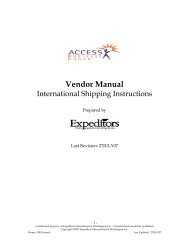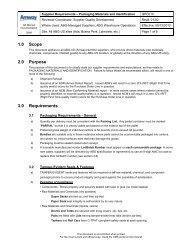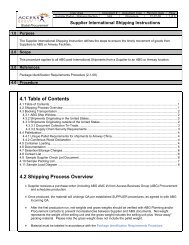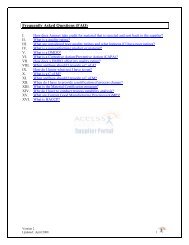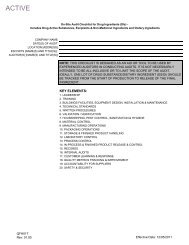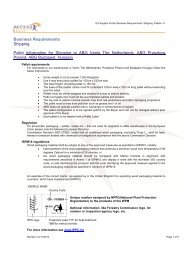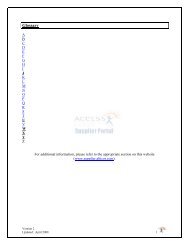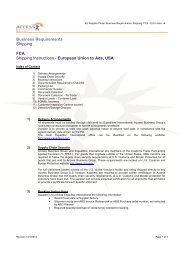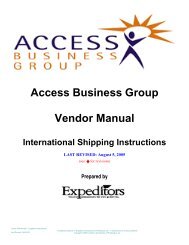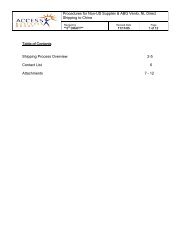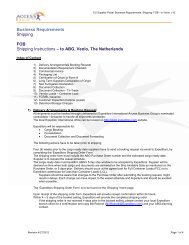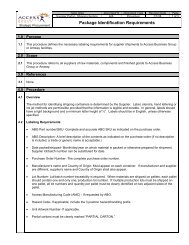QA Requirements - Amway
QA Requirements - Amway
QA Requirements - Amway
Create successful ePaper yourself
Turn your PDF publications into a flip-book with our unique Google optimized e-Paper software.
Quality Expectations:<br />
The Access Business Group (ABG) Quality Assurance Division (<strong>QA</strong>) strives to ensure and exceed our customers’<br />
expectation by verifying that the global enterprise complies with corporate quality standards and product regulatory<br />
requirements.<br />
We are committed in providing world class quality to our customers. Our Mission Statement is straightforward:<br />
“Quality Products through Quality People and Quality Systems.”<br />
Each <strong>QA</strong> area is committed to increasing quality throughout the supply chain. We expect our valued suppliers to be<br />
committed and contribute to our quality mission. We want to partner with and develop suppliers who share our goal of<br />
providing world class quality.<br />
Our expectation is that items shipped to ABG must meet all requirements listed in ABG product specifications, must be<br />
shipped on time, and must meet the applicable requirements described in this supplier manual. All suppliers should be<br />
proactive in the development and application of continuous improvement concepts. ABG expects all suppliers to actively<br />
drive quality improvements. The main emphasis should not be on the detection of nonconforming material, but rather on<br />
the prevention of nonconforming material.<br />
<strong>QA</strong> Incoming Inspection:<br />
Access Business Group (ABG) Quality Assurance (<strong>QA</strong>) utilizes Inspections to ensure that components, materials, and<br />
products conform to ABG specifications, to facilitate quality improvement, and to aid in new product development.<br />
Inspections are performed as a result of the following:<br />
• Incoming product or materials inspection<br />
• In-process inspection<br />
• Finished goods product inspection<br />
• Audits<br />
• Corrective actions<br />
• Supplier assessments<br />
• Validation and capability studies<br />
Most raw materials, manufactured products, and non-qualified supplier components or products require an inspection.<br />
Items are sampled, inspected, and tested according to the appropriate procedures, specifications, test methods, or<br />
sampling plans. Certificates of analysis may be used in addition to or in lieu of sampling, testing and inspection, where<br />
qualified and approved by <strong>QA</strong>.<br />
Certificate of Conformance / Analysis:<br />
Certificate of Conformance / Analysis may be required for items purchased by Access Business Group. If certificates are<br />
required, the supplier shall submit the certificate of conformance / analysis with every shipment. ABG <strong>QA</strong> will confirm that<br />
the certificates comply with the agreed specifications.<br />
Suppliers may fax, email, or attach certificates with the shipping documents. ABG prefers that suppliers email or fax<br />
these documents to the appropriate <strong>QA</strong> Department.<br />
Click below for information related to the required information for Certificate of Conformance and Certificate of Analysis.<br />
7575 Fulton Street East Ada, Michigan U.S.A. 49355 P 616.787.3000
"Certificate<br />
<strong>Requirements</strong>.xls"<br />
Non-Conforming Products and Materials:<br />
The definition of discrepant or non-conforming material is any product received into Access Business Group that does not<br />
conform to the specifications or agreed standards.<br />
• Products that do not meet specifications and must be reworked to be usable in our process are considered<br />
non-conforming material.<br />
• Products that do not meet the specifications and cannot be used in our process are considered nonconforming<br />
material.<br />
If a nonconforming product is found, ABG will notify the supplier by phone, fax, or email. A DMDO will be filled out. The<br />
supplier shall respond with an initial corrective action plan.<br />
Defect Classification:<br />
Non-Reportable (NR) — A defect that was noted upon examination but is of such size or consequence as to be<br />
insignificant to the end user.<br />
Minor Defect (MI) — A condition, which testing experience or judgment indicators would not affect product function - not<br />
greatly alter unit appearance, but which is objectionable when, found in large quantities.<br />
Major Defect (MA) — A condition in which testing experience or judgment indicates is detrimental to the salability of the<br />
finished products or any condition that renders the item unable to perform its intended function.<br />
Critical Defect — A condition in which testing experience or judgment indicates is likely to result in a hazardous and/or<br />
injurious situation to the user; or make the product subject to government seizure.<br />
Defective Material Disposition Order (DMDO):<br />
A Defective Material Disposition Order is the formal document notification applied to components or products that do not<br />
conform to established specifications or standards.<br />
ABG utilizes the DMDO system to control or quarantine nonconforming items, to provide a means of communicating the<br />
issue within ABG and to the supplier, and to ensure that the final agreed upon disposition is implemented. By measuring and<br />
tracking conformance quality history, <strong>QA</strong> personnel can identify trends, qualification candidates, and areas for improvement.<br />
External DMDO: ABG purchased product does not meet current specifications/standards and ABG did not adversely affect<br />
the usability of the product before or after receipt. Steps in an External DMDO:<br />
1. Product Non-conformance is found during receiving inspection and/or during manufacturing.<br />
2. ABG will quarantine the non-conforming product. DMDO is created. Supplier is notified of the non-conformance.<br />
Supplier CAR is initiated. ABG Planning and Purchasing is notified of the non-conformance.<br />
3. Supplier provides ABG with disposition (Scrap at Vendor’s Expense, Return to Vendor, or Rework).<br />
4. DMDO is route to NTBU for disposition. If product is “Return to Vendor”, suppliers are required to provide freight<br />
information (such as carrier, carrier contact information, account number to bill the freight, etc.).<br />
7575 Fulton Street East Ada, Michigan U.S.A. 49355 P 616.787.3000
5. Once disposition has been made to the product, the DMDO is route to ABG Procurement for Charge Back input.<br />
Suppliers may be charged with a $200.00 DMDO Administration Fee.<br />
6. DMDO is route to ABG <strong>QA</strong> for DMDO and Corrective Action closure.<br />
Other Types of DMDOs:<br />
1. OS&D DMDO (Over, Short and Damage): An OS&D is initiated by Receiving and Stores personnel whenever a<br />
shipment is received that is damaged or the actual quantity received does not match the supplier's and/or the carrier's<br />
shipping documents.<br />
2. ADR DMDO (Arrival Defect Report) - If an inbound shipment is not in compliance with Access Business Group's<br />
Supplier Shipping <strong>Requirements</strong>, Receiving personnel will initiate an Arrival Defect Report.<br />
ABG Terminology:<br />
1. Rejected/NTBU’d (Not to Be Used): Product contains non-conformances at or above the Acceptable Quality Level<br />
(AQL), or is deemed severe enough to affect use (functionally or aesthetically). Shipments can be either totally rejected or<br />
partially rejected, depending on the shipment and the severity.<br />
2. The Final Disposition of NTBU’d stock is classified as one of the following:<br />
• Rework Vendor Expense (RVE) — A DMDO disposition notice prepared by ABG indicating that rejected<br />
product, raw material, or component will be reworked at ABG and the charges will be forwarded to the supplier for<br />
payment.<br />
• Rework ABG Expense (RAE) — A DMDO disposition notice prepared by ABG indicating that rejected product,<br />
raw material, or component will be reworked at ABG and charged to ABG.<br />
• Scrap Vendor Expense (SVE) — A DMDO disposition notice prepared by <strong>Amway</strong>/ABG indicating that rejected<br />
product, raw material, or component will be scrapped at ABG and charged back to the supplier. ABG requires the<br />
supplier to provide a Return Material Authorization (RMA) #.<br />
• Scrap ABG Expense (SAE) — A DMDO disposition notice prepared by ABG indicating that rejected product, raw<br />
material, or component will be scrapped at <strong>Amway</strong> and charged to ABG.<br />
• Return to Vendor (RTV) — A DMDO disposition notice prepared by ABG that rejected product, raw material, or<br />
component does not meet specifications and is going to be returned to the source. ABG requires the supplier to<br />
provide a Return Material Authorization (RMA) #.<br />
• Release Under Deviation (RUD) — An ABG Quality disposition status for product that does not match<br />
specification or quality standards but is approved for use by <strong>QA</strong> “as-is” following consultation with areas of<br />
responsibility/expertise, i.e. R&D, Marketing, Purchasing, etc. RUDs, depending on the rationale, warrant an<br />
investigation that leads to correction or improvement of the process and/or revision of the specification. An<br />
“immediate” RUD can be executed by <strong>QA</strong> without going through a physical rejection step or a normal RUD may<br />
be the resulting disposition following a rejection. All RUDs should be supported by written rationale.<br />
Corrective Action Report:<br />
The Corrective Action process is used to identify and correct the root cause of one-time events or recurring nonconformances.<br />
The activity focuses on preventing the non-conformance from occurring again. Corrective action reports<br />
can positively impact productivity, reliability, and corporate reputation, while improving the ABG supplier relationship.<br />
The steps involved in a corrective action report are as follows:<br />
7575 Fulton Street East Ada, Michigan U.S.A. 49355 P 616.787.3000
1. Initiate Investigation – review details of the issue, including quality history.<br />
2. Determine Root Cause<br />
3. Document Finding<br />
4. Corrective Action – determine how the issue will be corrected and document implementation plan<br />
5. Evaluations – monitor and review procedures, processes, or quality as needed to ensure long-term resolution of<br />
the problem. Perform follow up audit if necessary.<br />
Suppliers are required to provide a Corrective Action Report (CAR) for all DMDO’s, explaining where and how the<br />
non-conformances occurred, and what will be done to correct and prevent such occurrences in the future.<br />
When a Corrective Action Report is initiated to the supplier, the supplier has 48 hours to provide ABG with an initial<br />
response. The initial response may include short-term corrective actions, such as containment activities.<br />
Final response is due to ABG 30 days after being initiated. ABG expects all CARs be submitted 100% on time with<br />
documentation supporting each action item.<br />
Correct Action Report <strong>Requirements</strong>:<br />
Example of ABG’s Corrective Action Form is attached. Suppliers may use any Corrective Action format that will address<br />
the required fields. Below is a description of what is required by ABG on a Corrective Action Report.<br />
Corrective Action Summary – This field is for a brief description of the issue related to why a corrective action was<br />
assigned. This includes quantities and lot numbers affected, ABG Purchase Order Number (if applicable), part number,<br />
Cause(s) – The description of a fundamental deficiency that results in a nonconformance.<br />
Root Cause(s) – Section that designates what type of fundamental deficiency occurred. (Manpower, Materials, Methods,<br />
Machine or Environment)<br />
Action(s) taken to correct the root causes and prevent recurrence – The description of action taken to eliminate the<br />
root cause(s) and symptom(s) of an existing undesirable deviation or nonconformity. The supplier shall verify that the<br />
actions performed are effective in eliminating the nonconformity.<br />
Status – Description of what stage the corrective action has reached.<br />
Due Date – Date assigned by ABG staff of when a corrective action response from the supplier is due.<br />
Dept. Assigned to Action – Department that will be responsible for the completion of the corrective action.<br />
Emp. Assigned to Action - Employee that will be responsible for the completion of the corrective action.<br />
Engineering Changes / Deviations:<br />
CAR.doc<br />
Suppliers (including sub-suppliers) shall not make changes of any nature, which would have an effect on part design,<br />
function, quality, durability, etc., without the approval of Access Business Group.<br />
A deviation may be used when a specific quantity or product being shipped or used is not in compliance with the specified<br />
specification. A deviation will be agreed to only if there is no other available inventory and the function, performance,<br />
safety, or durability of the end item is not affected. To receive approval for a deviation, the deviation will state the<br />
maximum quantity or period for which the deviation shall apply and the reason for the deviation.<br />
7575 Fulton Street East Ada, Michigan U.S.A. 49355 P 616.787.3000
Supplier Quality Development:<br />
SQD Vision: To build a foundation for world class quality through supply-based continuous<br />
improvement activities.<br />
SQD Mission: To proactively drive supplier quality development to deliver quality materials<br />
and products on time and on target.<br />
The Supplier Quality Development (SQD) program is a strategically focused approach, in alliance with Sourcing<br />
Strategy Team input, which leads to quality improvement strategies with key suppliers. SQD resources will monitor<br />
supplier quality performance and apply a variety of tools geared towards improvement.<br />
The ultimate goal is to drive improved quality starting at the supplier, which drives continuous improvement and a lower<br />
total cost of ownership for all involved. The primary components of the SQD program include proactive supplier audits,<br />
meaningful corrective action / preventative action, Advance Quality Planning, best practice sharing, performance metric<br />
oversight, and many other applicable tools.<br />
SQD Key Strategies:<br />
Development: Partner with new and existing ABG Suppliers to drive continuous improvement activities in the suppliers’<br />
manufacturing processes, quality systems, and customer services to achieve measurable improvement in quality.<br />
Performance: Systematically identify opportunities to improve supplier performance and proactively develop/drive<br />
Supplier Performance Improvement Plans, to achieve measurable improvement in supplier product quality, on-time<br />
delivery, and total lowest cost.<br />
Prevention: Lead by the Sourcing Strategy Teams and Advance Quality Planning initiative, the quality activities include<br />
assessing supplier manufacturing and quality capabilities, minimizing potential risks, and ensuring the effective<br />
implementation of ABG Quality Expectations to achieve on-time, on-target launches and exceptional supplier quality. The<br />
main emphasis should not be on the detection of nonconforming material, but rather on the prevention of nonconforming<br />
material.<br />
Supplier Audits:<br />
The intent of an on-site Supplier Audit is to review the management philosophies and practices, total quality system,<br />
address specific issues needing corrective action or to review technical and service capabilities of a potential supplier. In<br />
addition, Access Business Group (ABG) utilizes audits as a means to understand supplier capabilities and to drive<br />
supplier improvements as needed.<br />
The on-site supplier audit is a key tool in the Supplier Quality Development process. The types of audits conducted<br />
include:<br />
• New Supplier Assessment – A general overview of quality systems, as requested by Sourcing Strategy Teams<br />
or new Technology exploration.<br />
• Process/Scheduled Audit – Scheduled audits with key suppliers identified by SQD Selection Criteria and SST<br />
input. Designed for review of Quality process and procedures using either a GMP or ISO style audits.<br />
• Developmental Audit – Focused audits on areas for specific improvement. May address a particular corrective<br />
action and follow-up.<br />
• Verification/Follow-Up Audit – Audit to address implementation of a corrective action to ensure compliance.<br />
7575 Fulton Street East Ada, Michigan U.S.A. 49355 P 616.787.3000
ABG expects suppliers to have all processes documented<br />
and controlled such that product manufactured for ABG<br />
will meet requirements 100% of the time.<br />
Following an audit, ABG expects that all nonconforming items will result in effective corrective action as deemed<br />
appropriate by the ABG audit team. A follow up audit may be conducted to verify corrective action effectiveness.<br />
In addition, suppliers may be requested by ABG <strong>QA</strong> to complete and submit a Supplier Self Assessment. This self<br />
assessment is used to help ABG become familiar with the supplier’s quality system, prior to an audit.<br />
7575 Fulton Street East Ada, Michigan U.S.A. 49355 P 616.787.3000



